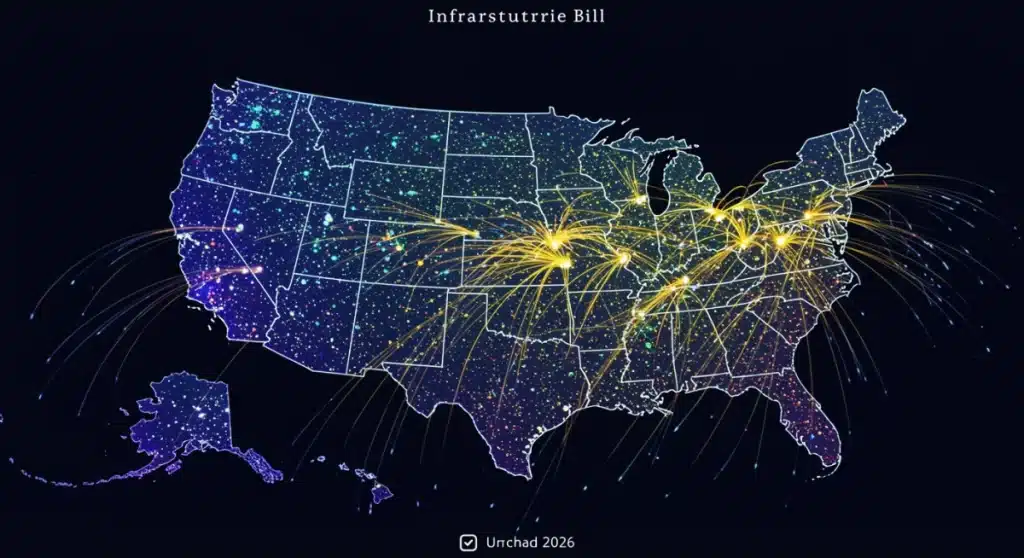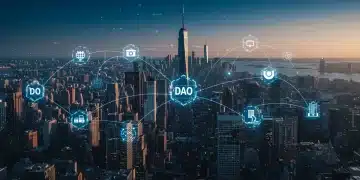US Infrastructure Bill: Broadband Access by 2026 Updates

Latest developments on how the new U.S. Infrastructure Bill impacts broadband access and digital inclusion by 2026 (recent updates) highlight critical funding, deployment strategies, and projected benefits for underserved American communities.
How the New U.S. Infrastructure Bill Impacts Broadband Access and Digital Inclusion by 2026 (RECENT UPDATES) remains a top priority, with significant progress and challenges emerging. This update focuses on the latest policy shifts, funding disbursements, and tangible outcomes as the nation strives to bridge the digital divide.
Understanding the Broadband Equity, Access, and Deployment (BEAD) Program
The Broadband Equity, Access, and Deployment (BEAD) Program, a cornerstone of the Infrastructure Investment and Jobs Act (IIJA), is the primary mechanism for expanding high-speed internet access. Launched with substantial federal funding, BEAD aims to ensure that every American has access to reliable and affordable broadband by 2026. Recent updates confirm that states are actively submitting their initial proposals, outlining how they plan to utilize their allocated funds.
These state proposals, currently under review by the National Telecommunications and Information Administration (NTIA), detail specific plans for infrastructure deployment, digital equity initiatives, and workforce development. The goal is not merely to lay cables but to create a sustainable ecosystem that supports digital literacy and accessibility for all. This rigorous planning phase is crucial, as it sets the foundation for how billions of dollars will be spent over the next few years, directly shaping the future of connectivity.
Key Funding Allocations and Timelines
- Total BEAD Funding: Over $42.45 billion allocated to states, territories, and Washington D.C.
- State Plan Submissions: Most states have submitted initial proposals, with final approvals expected through 2024.
- Target Deployment: Significant broadband infrastructure construction is anticipated to ramp up in late 2024 and throughout 2025-2026.
The urgency of these timelines is palpable, driven by the ambitious 2026 target. States are under pressure to demonstrate readiness and capacity to execute these complex projects, which involve intricate coordination between federal, state, local, and private entities. The success of BEAD hinges on efficient project management and overcoming logistical hurdles in diverse geographic terrains.
Impact on Underserved and Rural Communities
A primary objective of the Infrastructure Bill is to address the severe lack of broadband access in underserved and rural communities. These areas have historically been neglected due to the high cost of infrastructure deployment and lower population densities, making them less attractive for private investment. The BEAD program specifically targets these gaps, prioritizing projects that bring high-speed internet to homes and businesses currently without it.
Reports from the NTIA indicate a focused effort on identifying unserved locations, defined as those without access to 25/3 Mbps (download/upload) speeds, and underserved locations, which lack 100/20 Mbps speeds. This granular approach ensures that funding directly addresses the most critical needs. Community engagement has been a vital component, with states conducting extensive outreach to gather local input and tailor solutions that are truly impactful.
Bridging the Digital Divide
- Rural Expansion: New fiber optic networks are being planned for remote areas, drastically improving connectivity.
- Tribal Lands Focus: Dedicated efforts and funding are being channeled to improve broadband infrastructure on Tribal lands.
- Affordability Initiatives: Complementary programs like the Affordable Connectivity Program (ACP) help low-income households afford internet services.
The investment in these communities extends beyond mere connectivity; it aims to unlock economic opportunities, enhance educational outcomes, and improve access to telehealth services. For many, reliable broadband means the difference between isolation and integration into the modern digital economy. The progress by 2026 will be a critical measure of the bill’s success in achieving equitable access.
Digital Inclusion Initiatives and Equity Programs
Beyond physical infrastructure, the U.S. Infrastructure Bill places a strong emphasis on digital inclusion. This encompasses ensuring that all individuals have the skills, devices, and support needed to fully participate in the digital world. Digital equity programs are being implemented alongside broadband deployment to address various barriers, including digital literacy, device access, and language barriers.

Many states are developing comprehensive digital equity plans that include free or low-cost digital literacy training, device distribution programs, and technical support services. These initiatives recognize that simply providing internet access is not enough; people must also be equipped to use it effectively. Partnerships with local libraries, community centers, and non-profit organizations are central to delivering these vital services directly to those who need them most.
The goal is to dismantle systemic barriers that prevent marginalized communities from fully leveraging the benefits of broadband. By 2026, the aspiration is for a more digitally literate and digitally empowered populace, capable of navigating online resources for education, employment, healthcare, and civic engagement. This holistic approach to connectivity is crucial for long-term societal benefits.
Challenges and Oversight in Implementation
Implementing a program of this scale is not without its challenges. States and internet service providers (ISPs) face hurdles ranging from supply chain disruptions for equipment to a shortage of skilled labor for network deployment. Navigating complex permitting processes and ensuring environmental compliance also adds layers of complexity to project timelines.
Oversight mechanisms are therefore critical to ensure transparency, accountability, and efficient use of taxpayer dollars. The NTIA, along with other federal agencies, is establishing robust reporting requirements and performance metrics to track progress and identify potential bottlenecks. Audits and regular reviews are part of the strategy to prevent waste, fraud, and abuse, ensuring that funds are directed towards their intended purpose: expanding and improving broadband services.
Addressing Potential Roadblocks
- Supply Chain Issues: Ongoing monitoring and strategic sourcing to mitigate delays in equipment delivery.
- Workforce Development: Investment in training programs to cultivate a skilled broadband workforce.
- Permitting Streamlining: Efforts to simplify and expedite local and state permitting processes to accelerate deployment.
Despite these challenges, the commitment to the 2026 goal remains firm. Lessons learned from earlier broadband initiatives are informing current strategies, fostering a more adaptive and resilient approach to project management. The continuous feedback loop between federal agencies, states, and local communities is essential for addressing issues proactively and maintaining momentum.
Recent Updates on Funding Disbursements and Project Approvals
As of recent reports, several states have received approval for their initial BEAD proposals, enabling them to move forward with the next phases of their broadband deployment and digital equity plans. These approvals mark a significant milestone, transitioning from planning to tangible action. The NTIA has been working diligently to review proposals, providing feedback and necessary adjustments to ensure alignment with federal guidelines and objectives.
Early approved projects showcase a variety of approaches, from large-scale fiber-to-the-home deployments in rural areas to targeted digital literacy programs in urban centers. This diversity reflects the unique needs and geographic characteristics of different states. The disbursement of funds is often tied to meeting specific benchmarks and demonstrating progress, fostering a results-oriented environment.

Moreover, states are also leveraging other complementary federal programs, such as the Capital Projects Fund and USDA’s ReConnect Program, to maximize their impact. This layered funding approach ensures a comprehensive strategy for improving connectivity. The coming months will see a significant acceleration in project initiation across the country, with communities beginning to see the direct benefits of these investments.
What to Expect by 2026: A Forward Look
By 2026, the landscape of broadband access and digital inclusion in the United States is expected to be significantly transformed. The ambitious goals set forth by the Infrastructure Bill aim to virtually eliminate the digital divide, ensuring that nearly all Americans have access to high-speed internet. This will not only mean physical connectivity but also widespread digital literacy and device access, particularly in previously underserved areas.
The economic and social benefits are projected to be substantial. Increased broadband access is anticipated to spur job creation, foster small business growth, and enhance educational opportunities. Telehealth services will become more accessible, and civic engagement is expected to rise as more citizens gain the tools to participate in online governance. The focus on sustainability means that the infrastructure built today is intended to serve communities for decades to come.
Furthermore, the lessons learned from this massive undertaking will inform future infrastructure projects, establishing best practices for public-private partnerships and community-led development. The journey to universal broadband is complex, but the recent updates indicate a determined and structured path toward achieving the 2026 vision of a more connected and digitally inclusive America.
Measuring Success and Long-Term Sustainability
The success of the U.S. Infrastructure Bill’s broadband initiatives by 2026 will be measured by several key indicators beyond just the number of homes passed with fiber. Critical metrics include the actual adoption rates of high-speed internet, the reduction in digital literacy gaps, and the economic impact on previously unserved communities. The NTIA and state broadband offices are developing robust frameworks for data collection and analysis to track these outcomes diligently.
Long-term sustainability is also a core consideration. The infrastructure being deployed is designed to be future-proof, capable of supporting evolving technological demands. This includes prioritizing fiber deployments where feasible and ensuring networks are scalable. Additionally, efforts to foster local competition among ISPs are intended to keep prices affordable and service quality high in the long run, preventing new digital divides from emerging.
Sustainable Broadband Ecosystems
- Future-Proof Infrastructure: Emphasis on fiber optics to meet future bandwidth demands.
- Local Competition: Policies encouraging multiple providers to ensure competitive pricing and service.
- Community Partnerships: Ongoing collaboration with local entities for sustained digital inclusion programs.
The commitment extends beyond the initial deployment phase, aiming to cultivate self-sufficient digital ecosystems within communities. This includes supporting local IT talent, promoting digital entrepreneurship, and ensuring that residents have continuous access to support and training. The vision for 2026 is not merely about construction but about building resilient, connected communities ready for the digital future.
Key Aspect |
Description |
|---|---|
BEAD Program |
Over $42B allocated for states to expand high-speed internet access. |
Target Communities |
Prioritizes unserved and underserved rural areas and Tribal lands. |
Digital Inclusion |
Funds digital literacy training, device access, and support programs. |
2026 Outlook |
Aims for near-universal high-speed internet access and increased digital equity. |
Frequently Asked Questions About Broadband Access
▼
The primary goal is to ensure that all Americans have access to reliable
and affordable high-speed internet by 2026, specifically targeting
unserved and underserved communities through significant federal funding
and strategic deployment initiatives.
▼
The Broadband Equity, Access, and Deployment (BEAD) Program, a key part
of the Infrastructure Bill, has allocated over $42.45 billion to states,
territories, and Washington D.C. for broadband infrastructure and digital
equity efforts.
▼
Digital inclusion refers to ensuring that individuals have the necessary
skills, devices, and support to effectively use the internet. The bill
funds programs for digital literacy, device distribution, and technical
assistance to overcome access barriers.
▼
States are encountering challenges such as supply chain disruptions for
equipment, shortages of skilled labor, and complex permitting processes.
Federal agencies are working with states to mitigate these issues and
streamline deployment.
▼
Long-term benefits include enhanced economic opportunities, improved
educational outcomes, better access to telehealth services, and increased
civic engagement. The goal is to create sustainable, future-proof digital
ecosystems across the nation.
Looking Ahead: The Road to a Connected Nation
The ongoing implementation of the U.S. Infrastructure Bill’s broadband provisions represents a monumental national effort. As we approach 2026, the focus remains on transforming policy into tangible connectivity, addressing the digital divide head-on. Continued vigilance in oversight, adaptive strategies for emerging challenges, and sustained community engagement will be paramount to realizing the vision of universal, equitable, and sustainable broadband access for all Americans, fundamentally reshaping the nation’s digital future.





